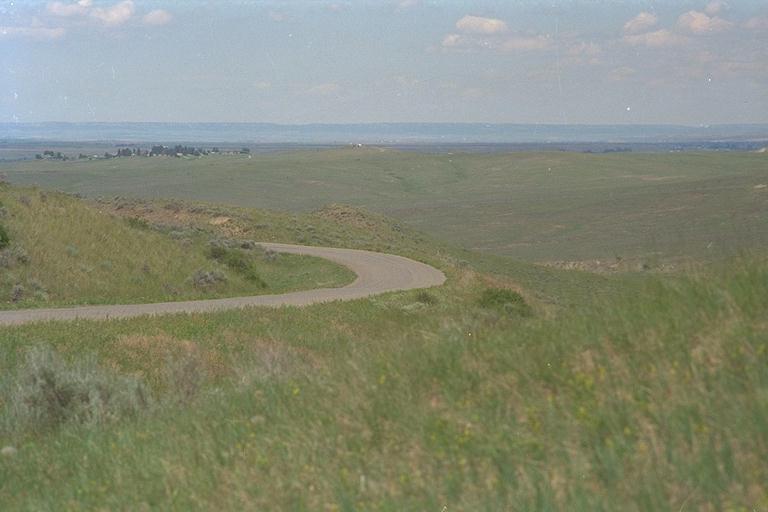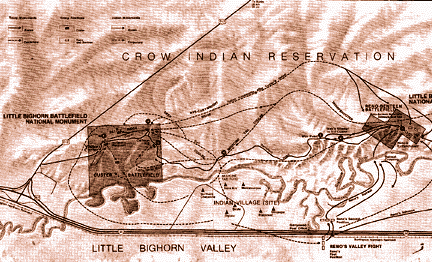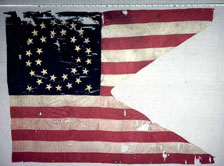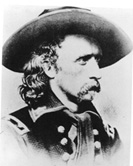




Amanda Wright
8th American History
Rossville Jr. High
Plains History Project
2004
|
|
|
| The people that were in The Battle of Little Bighorn were: Seventh Cavalry with 700 men, the Sioux and Cheyenne Indians with 15,00 people, and about 3,00 to 4,00 warriors. | |
| On June 25-26, 1876 the Battle of Little Bighorn happened along the river of Little Bighorn in Montana. Also in the month of June on June 25th, Custer deiced to attack while waiting for the rest of the troops. |  |
| Gold had been found around Idaho and Montana. Miners quickly demanded better and easier highways. In the Colorado Rockies gold was discovered in the years 1858-1859. There was a trail from Fort Laramie to Bozeman, Montana. The military built roads and protected military posts in the middle of buffalo hunting territory . Spotted Tail and Red Cloud were quick to see what the new roads meant. Their hunting territory would be gone. | |
| During 1865, Indians argued with surveying parties and tried to intimidate them. July 1st through December 21st, 1866, Red Cloud and his warriors killed 91 solders, 5 officers and 58 citizens. The whites built Fort Phil Kearny, on Piney Creek in very heart of buffalo country. Also on December 21st, 1866 Fetterman, with 80 picked soldiers, was to rescue a wood train seized by the Indians. Red Cloud wanted to destroy Fort Phil. Kearny and capture the wood train. | |
| U.S had more than three thousand warriors and Sioux had five hundred warriors. Red Cloud began his movement. Six charges were made, with bad results. The Indians believed that the only way they could preserved the rights was to make war. | |
| In March with 803 men, Crook scouted Rosebud by the old Bozeman trail, which was Crazy Horse's camp with the Indians. They escaped to the hills. Crook's troops, 1,049 solders and officers, left Fort Fetterman on May 29th. |  |
| One June 17, Crazy Horse fought an all-day engagement, the Battle of Rosebud. Custer and his scout first went over the mountains forming a divide between Rosebud and Little Bighorn. Down far away from them to the went was the Little Bighorn Valley. There was a cloud of smoke and a large of Indian camp. On June 25-26 were the most celebrated Indians wars. Boyer sent a note by Red Star, a scout, to Custer who went up close to divide between the Rosebud and Little Bighorn Creek. Much of Sioux encampment was plainly in sight. | |
| Custer talked with his troops about the situation, the nature of the ground, the best routs to follow. Then the road back to his command. The Sioux were everywhere across the Little Bighorn. |  |
| Custer's command from the valley came up close to the crest of the hill. Custer reached the lookout. One-half to three-fourths of the Indian encampment was in plain sight. Custer reached the Sioux camp in less than ten minutes and they stopped there. Custer attacked the camp without waiting for the main column of his men. He divided his regiment into three battalions. Custer marched opposite of the banks down a small creek toward the Indian Village in Little Bighorn Valley. Custer turned north to the lower end of the Indian camp. It was there where the attack on Custer began. General Custer's Seventh Cavalry was annihilated in the battle. Custer and his immediate command about 225 men were wiped out. | |
| Indians had gained the
greatest
victory in the Indian wars so far. Custer fought the last hour before all
his men were dead.
|

|
|
Amanda Wright 8th American History Rossville Jr. High Plains History Project 2004 |
|